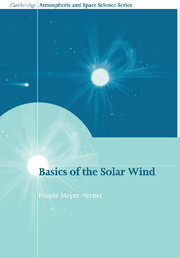Book contents
- Frontmatter
- Contents
- Preface
- 1 The wind from the Sun: an introduction
- 2 Tool kit for space plasma physics
- 3 Anatomy of the Sun
- 4 The outer solar atmosphere
- 5 How does the solar wind blow?
- 6 Structure and perturbations
- 7 Bodies in the wind: dust, asteroids, planets and comets
- 8 The solar wind in the Universe
- Appendix
- Index
7 - Bodies in the wind: dust, asteroids, planets and comets
Published online by Cambridge University Press: 22 October 2009
- Frontmatter
- Contents
- Preface
- 1 The wind from the Sun: an introduction
- 2 Tool kit for space plasma physics
- 3 Anatomy of the Sun
- 4 The outer solar atmosphere
- 5 How does the solar wind blow?
- 6 Structure and perturbations
- 7 Bodies in the wind: dust, asteroids, planets and comets
- 8 The solar wind in the Universe
- Appendix
- Index
Summary
We are no other than a moving row
Of Magic Shadow-shapes that come and go
Round with the Sun-illumined Lantern held
In Midnight by the Master of the Show;
Omar Khayyam, RubaiyatThe light of the Sun heats the bodies of the Solar System, making them evaporate, and driving their atmospheres, while photons of adequate energy ionise the surfaces and atmospheres. But the wind of the Sun does much more: it carves these environments, producing elaborate structures and powering mighty engines.
The Solar System bodies are extremely diverse, from dust grains to asteroids, comets, planets – and space probes. Even though the interactions are extremely diverse, too, depending on the flow properties, on the nature of the object, and on its size relative to the basic plasma scales, they illustrate similar basic processes. We survey in this chapter the different kinds of bodies and the basic physics of their interaction with the solar wind.
The range of sizes is very large: from small dust grains made of minute assemblages of atoms, to the largest planet, Jupiter. The small dust grains respond to a number of forces: the solar gravitational and radiative forces, electrostatic and Lorentz forces (since they carry an electric charge), and the ram pressure of the solar wind. Because these objects are much smaller than the basic scales of the medium, they do not perturb it significantly, except through the exchange of particles that are absorbed on their surface or emitted.
- Type
- Chapter
- Information
- Basics of the Solar Wind , pp. 335 - 418Publisher: Cambridge University PressPrint publication year: 2007



